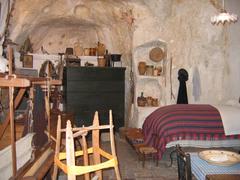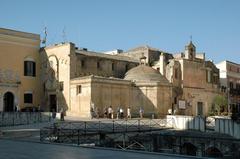
E. Duni Matera Italy Visiting Hours, Tickets, and Historical Sites Guide
Date: 04/07/2025
Introduction: E. Duni and Matera’s Cultural Renaissance
Matera, a city with over 9,000 years of continuous human habitation, is renowned for its dramatic landscapes, ancient cave dwellings (Sassi), and a vibrant resurgence as a cultural capital. Central to this renaissance are the E. Duni Institutions: the Conservatorio di Musica Egidio Romualdo Duni, Teatro Duni, and the Liceo Classico. Named after the celebrated 18th-century Materan composer Egidio Romualdo Duni, these institutions are not only custodians of local musical heritage but also dynamic centers for education, performance, and community engagement.
Located within Matera’s UNESCO-listed historic center, the E. Duni Institutions have played a pivotal role in transforming the city from its troubled past as the “shame of Italy” into a beacon of artistic excellence and cultural innovation. The restored Teatro Duni, built in 1947, serves as the city’s premier venue for concerts and theatrical events, while the Conservatory’s robust educational and outreach programs nurture both local and international talent. This guide details everything you need to know about visiting E. Duni and Matera’s top historical sites, including practical information on hours, tickets, accessibility, events, and tips for crafting an unforgettable cultural experience (Conservatorio di Musica E. R. Duni; Festival Duni; Matera Tourism Information).
Table of Contents
- Matera: Geography, History, and Cultural Identity
- Visiting the E. Duni Institutions: History, Significance, and How to Visit
- Teatro Duni and Festival Duni: Highlights and Events
- Exploring Other Matera Historical Sites
- Culinary Traditions and Contemporary Culture
- FAQs and Visitor Tips
- Summary and Final Advice
- References
Matera: Geography, History, and Cultural Identity
Geographic Setting
Matera is set atop a deep ravine carved by the Gravina River, with the iconic Sassi districts—Sasso Caveoso and Sasso Barisano—forming a labyrinth of ancient stone dwellings and churches cut into the limestone cliffs (Go Ask a Local; Earth Trekkers). Above the Sassi, the Civita district features the 13th-century Matera Cathedral and panoramic views over the Murgia plateau (Voyage Tips).
Historical Timeline
- Prehistory & Antiquity: Matera is among the world’s oldest cities, with settlement since the Paleolithic era. Early inhabitants excavated cave homes, evolving into complex communities by the Neolithic period (Earth Trekkers).
- Middle Ages: The city thrived as a crossroads of civilizations, marked by the creation of more than 150 rock-hewn churches, many decorated with Byzantine frescoes and significant as religious and artistic sites (Tourist Places Guide).
- Modern Decline & Revival: In the 19th and 20th centuries, poverty and disease plagued the Sassi, leading to mass relocations in the 1950s. Restoration efforts began in the 1980s, culminating in UNESCO World Heritage status in 1993 (UNESCO).
- European Capital of Culture 2019: Matera’s transformation was celebrated with major festivals and a surge in international visitors, cementing its role as a cultural beacon (Matera News).
Cultural and Architectural Identity
The Sassi’s cave homes, cisterns, and churches offer a glimpse into troglodyte life, while the Duomo di Matera and the Crypt of the Original Sin exemplify the city’s religious and artistic richness (Continuous Roamer). Today, many caves house museums, shops, and restaurants, blending ancient atmosphere with modern hospitality.
Visiting the E. Duni Institutions: History, Significance, and How to Visit
Historical Background
The E. Duni Institutions are foundational to Matera’s modern cultural landscape:
- Conservatorio di Musica “E.R. Duni”: Established in the late 1960s as an offshoot of the Bari Conservatory under composer Nino Rota, it became autonomous in the 1970s and has since gained national recognition (raffaelegervasio.com).
- Teatro Duni: Built in 1947, this neoclassical structure is celebrated for its acoustics and architectural elegance.
- Liceo Classico: One of Matera’s oldest secondary schools, focusing on classical studies and contributing to local cultural life.
Key Figures and Milestones
- Egidio Romualdo Duni: 18th-century composer and the institutions’ namesake.
- Nino Rota: First director of the Conservatory’s Matera division, known for his film scores.
- Raffaele Gervasio: First director after autonomy, pivotal in shaping the Conservatory’s reputation (raffaelegervasio.com).
Community Impact and Artistic Events
The Conservatory and Teatro Duni spearhead Matera’s musical programming, hosting concerts, masterclasses, and collaborations with schools and cultural organizations (trmtv.it). Initiatives like the Orchestra di Fiati and Festival Duni foster local talent and bring international artists to Matera (Festival Duni).
Practical Visitor Information
Visiting Hours
- Teatro Duni: Box office generally open Tuesday–Saturday, 10:00 AM–1:00 PM & 4:00 PM–7:00 PM. Performance times vary; check official schedules.
- Conservatorio di Musica: Open Monday–Friday, 9:00 AM–6:00 PM. Event times may differ for concerts or workshops (Conservatorio di Musica E. R. Duni).
- Liceo Classico: Not typically open for visits, but participates in public events and festivals.
Tickets and Reservations
- Teatro Duni: Tickets (€10–€40) are available online, at the box office, or through local tourism offices. Early booking is advised for major events.
- Conservatory Events: Many are free or low-cost, but some require reservations.
- Festival Duni: Tickets (€15–€40) can be purchased via the official Festival Duni website.
Accessibility
Recent renovations have enhanced wheelchair access and facilities in both Teatro Duni and the Conservatory. Contact venues ahead for special accommodations.
Visitor Tips
- Book tickets in advance, especially during peak festival seasons.
- Dress smart casual for performances; photography is generally restricted during shows.
- Arrive early to enjoy the ambiance and architecture.
Teatro Duni and Festival Duni: Highlights and Events
Theater Architecture and Restoration
Teatro Duni, a modernist landmark built in 1947, features Carrara marble, grand staircases, and expansive glasswork (lagazzettadelmezzogiorno.it). The venue is currently closed for restoration until late 2025, with plans to improve accessibility and visitor facilities.
Festival Duni
Since 1999, Festival Duni has celebrated southern Italian and early music, drawing international artists and audiences. Events are held across Matera’s historic venues and nearby towns, offering a unique musical journey through time (rema-eemn.net).
Exploring Other Matera Historical Sites
Augment your cultural itinerary with these highlights:
- Sassi di Matera: UNESCO-listed cave dwellings (italyunseen.com).
- Casa Grotta nei Sassi: Museum of cave life.
- Crypt of the Original Sin: 8th-century frescoes (Along Dusty Roads).
- Palazzo Lanfranchi: Art museum (Italy Scapes).
- MUSMA: Museum of contemporary sculpture (Momin Italy).
Culinary Traditions and Contemporary Culture
Matera’s culinary scene is rooted in rustic traditions—“Pane di Matera” bread, orecchiette pasta, lamb, and legumes are staples. Many restaurants are set inside ancient caves, providing a memorable dining experience (Go Ask a Local).
The city’s cinematic scenery has featured in films such as “The Passion of the Christ” and “No Time to Die,” adding to its global allure (Earth Trekkers).
FAQs and Visitor Tips
Q: What are E. Duni’s visiting hours?
A: Conservatory: Mon–Fri, 9:00 AM–6:00 PM. Teatro Duni: Check event calendar; closed for restoration until late 2025.
Q: How can I buy tickets?
A: Online, box office, or tourism offices for Teatro Duni and Festival Duni. Conservatory events may require reservations (Festival Duni; Conservatorio di Musica E. R. Duni).
Q: Are the institutions accessible?
A: Yes, recent upgrades support wheelchair access. Contact ahead for specific needs.
Q: What else should I see nearby?
A: Sassi di Matera, Palazzo Lanfranchi, MUSMA, and the Crypt of the Original Sin.
Q: Where can I eat near the venues?
A: Numerous restaurants offer local cuisine in historic settings (mammamiaindeed.com).
Visitor Tips:
- Wear comfortable shoes—Matera’s streets are steep and cobbled.
- Check for special events or guided tours.
- Respect photography and noise guidelines during performances.
- Consider staying overnight in a cave hotel for a unique experience (Momin Italy).
Summary and Final Advice
The E. Duni Institutions are at the heart of Matera’s cultural revival. Whether you’re attending a concert at Teatro Duni, exploring the Conservatory’s events, or marveling at the architectural heritage, you’re participating in a living tradition that bridges Matera’s ancient past and dynamic present. Plan your visit in advance, check official sources for the latest information, and use tools such as the Audiala app to enhance your travel experience. Matera and the E. Duni Institutions welcome you to discover their enduring charm and creative energy (Festival Duni; Conservatorio di Musica E. R. Duni; Matera Tourism Information).
References and Further Reading
- Visiting the E. Duni Institutions in Matera: Teatro Duni Tickets, Hours & Cultural Highlights, 2025 (raffaelegervasio.com)
- Matera: A Complete Visitor’s Guide to History, Culture, and Practical Information, 2024 (Go Ask a Local)
- E. Duni Theater in Matera: Visiting Hours, Tickets & Cultural Highlights, 2024 (Festival Duni)
- Visiting E. Duni in Matera: Visiting Hours, Tickets, and Cultural Significance, 2024 (Conservatorio di Musica E. R. Duni)
- Matera Tourism Information, 2024 (Matera Tourism Information)



